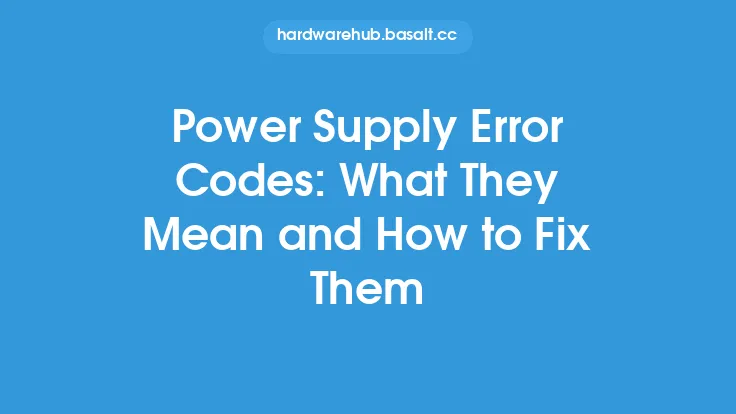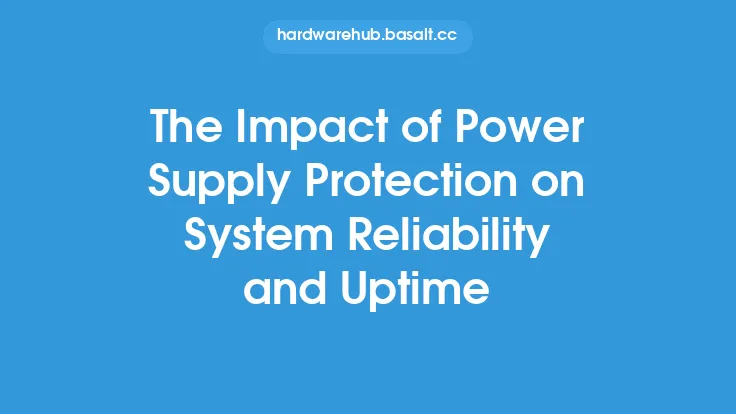When it comes to power supply units (PSUs), understanding the basics of voltage, current, and power is essential for selecting the right PSU for your system and ensuring reliable operation. These fundamental concepts are crucial in the world of electronics and are used to describe the capabilities and limitations of PSUs. In this article, we will delve into the details of voltage, current, and power, exploring how they relate to PSUs and what you need to know when choosing a PSU for your computer.
Voltage
Voltage, measured in volts (V), is the potential difference between two points in a circuit. It is the driving force that pushes electric current through a circuit. In the context of PSUs, voltage refers to the output voltage of the PSU, which is typically 3.3V, 5V, 12V, -5V, -12V, or a combination of these. The voltage output of a PSU is critical, as it must match the requirements of the components in your system. For example, a CPU may require a voltage of 1.2V, while a graphics card may require 12V. PSUs use voltage regulators to convert the input voltage from the mains to the required output voltages.
Current
Current, measured in amperes (A), is the flow of electric charge through a circuit. It is the amount of electric charge that flows through a given point in a circuit per unit time. In the context of PSUs, current refers to the maximum amount of current that a PSU can supply to a circuit. The current output of a PSU is typically specified in terms of the maximum current that can be drawn from each voltage rail. For example, a PSU may be able to supply 20A on the 3.3V rail, 15A on the 5V rail, and 30A on the 12V rail. The current output of a PSU is critical, as it must be able to supply enough current to power all the components in your system.
Power
Power, measured in watts (W), is the rate at which electric energy is transferred by an electric circuit. It is the product of voltage and current, and is calculated using the formula: power (W) = voltage (V) x current (A). In the context of PSUs, power refers to the maximum amount of power that a PSU can supply to a system. The power output of a PSU is typically specified in terms of the total power that can be drawn from all the voltage rails. For example, a PSU may have a total power output of 650W, with 100W available on the 3.3V and 5V rails, and 550W available on the 12V rail. The power output of a PSU is critical, as it must be able to supply enough power to run all the components in your system.
Efficiency
Efficiency, measured as a percentage, is the ratio of the output power of a PSU to the input power. It is a measure of how effectively a PSU can convert the input power from the mains to the output power required by the system. A high-efficiency PSU will waste less power as heat, and will therefore be more reliable and cost-effective. The efficiency of a PSU is typically specified using the 80 PLUS certification program, which rates PSUs as Bronze, Silver, Gold, Platinum, or Titanium, based on their efficiency at 20%, 50%, and 100% loads.
Rail Distribution
Rail distribution refers to the way in which a PSU distributes power across its voltage rails. There are two main types of rail distribution: single-rail and multi-rail. A single-rail PSU has a single 12V rail that can supply power to all the components in the system. A multi-rail PSU, on the other hand, has multiple 12V rails, each of which can supply power to a specific group of components. The advantage of a multi-rail PSU is that it can provide more flexible power distribution, and can help to prevent overloading of individual components.
Overcurrent Protection
Overcurrent protection (OCP) is a feature that is designed to prevent a PSU from supplying too much current to a circuit. OCP is typically implemented using a current-sensing circuit that monitors the current flowing through each voltage rail, and shuts down the PSU if the current exceeds a predetermined limit. OCP is an important safety feature, as it can help to prevent damage to components and reduce the risk of fire.
Undervoltage Protection
Undervoltage protection (UVP) is a feature that is designed to prevent a PSU from supplying too low a voltage to a circuit. UVP is typically implemented using a voltage-sensing circuit that monitors the voltage output of each voltage rail, and shuts down the PSU if the voltage falls below a predetermined limit. UVP is an important safety feature, as it can help to prevent damage to components and reduce the risk of data loss.
Overvoltage Protection
Overvoltage protection (OVP) is a feature that is designed to prevent a PSU from supplying too high a voltage to a circuit. OVP is typically implemented using a voltage-sensing circuit that monitors the voltage output of each voltage rail, and shuts down the PSU if the voltage exceeds a predetermined limit. OVP is an important safety feature, as it can help to prevent damage to components and reduce the risk of fire.
Short-Circuit Protection
Short-circuit protection (SCP) is a feature that is designed to prevent a PSU from supplying power to a circuit that has a short-circuit. SCP is typically implemented using a current-sensing circuit that monitors the current flowing through each voltage rail, and shuts down the PSU if the current exceeds a predetermined limit. SCP is an important safety feature, as it can help to prevent damage to components and reduce the risk of fire.
In conclusion, understanding the basics of voltage, current, and power is essential for selecting the right PSU for your system and ensuring reliable operation. By considering factors such as voltage, current, power, efficiency, rail distribution, and protection features, you can choose a PSU that meets your needs and provides reliable power to your system. Whether you are building a new computer or upgrading an existing one, a good PSU is essential for ensuring reliable operation and preventing damage to components.





